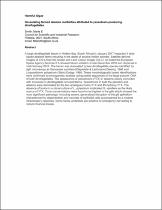 ResearchSpace
ResearchSpace
Devastating farmed abalone mortalities attributed to yessotoxin-producing dinoflagellates
JavaScript is disabled for your browser. Some features of this site may not work without it.
- ResearchSpace
- →
- Research Publications/Outputs
- →
- Journal Articles
- →
- View Item
| dc.contributor.author |
Pitcher, GC

|
|
| dc.contributor.author |
Foord, CJ

|
|
| dc.contributor.author |
Macey, BM

|
|
| dc.contributor.author |
Mansfield, L

|
|
| dc.contributor.author |
Mouton, A

|
|
| dc.contributor.author |
Smith, Marie E

|
|
| dc.contributor.author |
Osmond, SJ

|
|
| dc.contributor.author |
Van der Molen, L

|
|
| dc.date.accessioned | 2020-03-17T13:07:00Z | |
| dc.date.available | 2020-03-17T13:07:00Z | |
| dc.date.issued | 2019-01 | |
| dc.identifier.citation | Pitcher, G.C. et al. 2019. Devastating farmed abalone mortalities attributed to yessotoxin-producing dinoflagellates. Harmful Algae, vol. 81, pp. 30-41 | en_US |
| dc.identifier.issn | 1568-9883 | |
| dc.identifier.issn | 1878-1470 | |
| dc.identifier.uri | https://www.sciencedirect.com/science/article/pii/S1568988318301677 | |
| dc.identifier.uri | https://doi.org/10.1016/j.hal.2018.11.006 | |
| dc.identifier.uri | http://hdl.handle.net/10204/11328 | |
| dc.description | Copyright: 2019 Elsevier. Due to copyright restrictions, the attached PDF file only contains the abstract of the full text item. For access to the full text item, please consult the publisher's website. The definitive version of the work is published in Harmful Algae, vol. 81, pp. 30-41 | en_US |
| dc.description.abstract | A large dinoflagellate bloom in Walker Bay (South Africa) in January 2017 impacted 3 land-based abalone farms resulting in the death of several million animals. Satellite-derived images of Chl-a from the Ocean and Land Colour Imager (OLCI) on board the European Space Agency Sentinel-3 A showed bloom initiation in late December 2016 and dispersal in mid-February 2017. The bloom was dominated by two dinoflagellate species identified by light microscopy as Gonyaulax spinifera (Claparède & Lachmann) Diesing, 1866 and Lingulodinium polyedrum (Stein) Dodge, 1989. These morphologically based identifications were confirmed by phylogenetic analysis using partial sequences of the large subunit rDNA of both dinoflagellates. The appearance of yessotoxins (YTX) in abalone clearly coincided with increases in dinoflagellate concentrations. Yessotoxins in both the plankton and abalone were dominated by the two analogues homo-YTX and 45-hydroxy-YTX. The absence of toxins in a clonal culture of L. polyedrum implicated G. spinifera as the likely source of YTX. Toxin concentrations were found to be highest in the gills which showed the most significant pathology, including severe, generalized disruption of the gill epithelium characterized by degeneration and necrosis of epithelial cells accompanied by a modest inflammatory response. Some farms undertook pre-emptive or emergency harvesting to reduce financial losses. | en_US |
| dc.language.iso | en | en_US |
| dc.publisher | Elsevier | en_US |
| dc.relation.ispartofseries | Workflow;23218 | |
| dc.subject | Abalone mortality | en_US |
| dc.subject | Gonyaulax spinifera | en_US |
| dc.subject | Harmful algal blooms | en_US |
| dc.subject | HAB | en_US |
| dc.subject | Lingulodinium polyedrum | en_US |
| dc.subject | Yessotoxins | en_US |
| dc.title | Devastating farmed abalone mortalities attributed to yessotoxin-producing dinoflagellates | en_US |
| dc.type | Article | en_US |
| dc.identifier.apacitation | Pitcher, G., Foord, C., Macey, B., Mansfield, L., Mouton, A., Smith, M. E., ... Van der Molen, L. (2019). Devastating farmed abalone mortalities attributed to yessotoxin-producing dinoflagellates. http://hdl.handle.net/10204/11328 | en_ZA |
| dc.identifier.chicagocitation | Pitcher, GC, CJ Foord, BM Macey, L Mansfield, A Mouton, Marie E Smith, SJ Osmond, and L Van der Molen "Devastating farmed abalone mortalities attributed to yessotoxin-producing dinoflagellates." (2019) http://hdl.handle.net/10204/11328 | en_ZA |
| dc.identifier.vancouvercitation | Pitcher G, Foord C, Macey B, Mansfield L, Mouton A, Smith ME, et al. Devastating farmed abalone mortalities attributed to yessotoxin-producing dinoflagellates. 2019; http://hdl.handle.net/10204/11328. | en_ZA |
| dc.identifier.ris | TY - Article AU - Pitcher, GC AU - Foord, CJ AU - Macey, BM AU - Mansfield, L AU - Mouton, A AU - Smith, Marie E AU - Osmond, SJ AU - Van der Molen, L AB - A large dinoflagellate bloom in Walker Bay (South Africa) in January 2017 impacted 3 land-based abalone farms resulting in the death of several million animals. Satellite-derived images of Chl-a from the Ocean and Land Colour Imager (OLCI) on board the European Space Agency Sentinel-3 A showed bloom initiation in late December 2016 and dispersal in mid-February 2017. The bloom was dominated by two dinoflagellate species identified by light microscopy as Gonyaulax spinifera (Claparède & Lachmann) Diesing, 1866 and Lingulodinium polyedrum (Stein) Dodge, 1989. These morphologically based identifications were confirmed by phylogenetic analysis using partial sequences of the large subunit rDNA of both dinoflagellates. The appearance of yessotoxins (YTX) in abalone clearly coincided with increases in dinoflagellate concentrations. Yessotoxins in both the plankton and abalone were dominated by the two analogues homo-YTX and 45-hydroxy-YTX. The absence of toxins in a clonal culture of L. polyedrum implicated G. spinifera as the likely source of YTX. Toxin concentrations were found to be highest in the gills which showed the most significant pathology, including severe, generalized disruption of the gill epithelium characterized by degeneration and necrosis of epithelial cells accompanied by a modest inflammatory response. Some farms undertook pre-emptive or emergency harvesting to reduce financial losses. DA - 2019-01 DB - ResearchSpace DP - CSIR KW - Abalone mortality KW - Gonyaulax spinifera KW - Harmful algal blooms KW - HAB KW - Lingulodinium polyedrum KW - Yessotoxins LK - https://researchspace.csir.co.za PY - 2019 SM - 1568-9883 SM - 1878-1470 T1 - Devastating farmed abalone mortalities attributed to yessotoxin-producing dinoflagellates TI - Devastating farmed abalone mortalities attributed to yessotoxin-producing dinoflagellates UR - http://hdl.handle.net/10204/11328 ER - | en_ZA |





